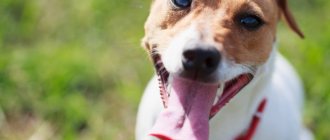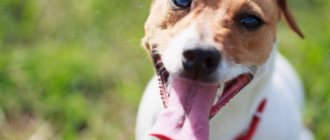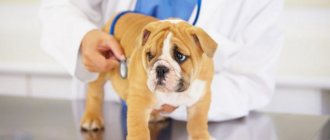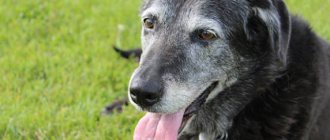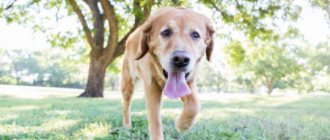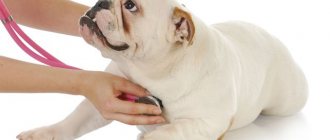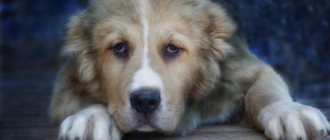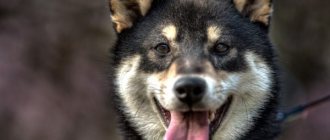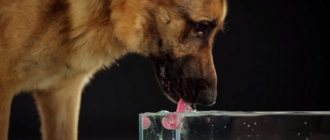Normal breathing in a dog
The condition is considered normal when the pet's mouth is closed and the person does not hear inhalations and exhalations. The dog owner can independently determine the breathing rate. To do this, place your hand on the chest and count the number of lifts over a certain time interval.
Normal values vary from person to person and depend on the size of the dog. The metabolic rate of small dogs is higher than that of large dogs, so 20 to 40 chest rises per minute are taken as the norm. Healthy giants take 10 to 20 breaths.
What to do: emergency care at home
Hospitalization is resorted to only in special cases, when the animal is very ill or may die; in other cases, they are treated at home, after the treatment prescribed by the veterinarian. For a speedy recovery, you must follow some rules:
- provide the necessary amount of water to drink, otherwise a lack of fluid can lead to a depressed state;
- follow all recommendations of your attending physician;
- do not self-medicate.
And most importantly, do not miss appointments with the veterinarian under any circumstances, because any changes noticed in time in your pet’s health will save his life.
Causes of rapid breathing
Physiological causes of excessive breathing are not accompanied by additional symptoms. Tachypnea occurs and resolves spontaneously and does not require treatment.
When is rapid breathing normal?
The respiratory rate increases in the following cases:
- predisposition in certain breeds;
- stressful conditions: traveling in transport, fright, visiting a clinic, reaction to thunder, explosions of firecrackers, loud music;
- joy;
- the dog ran a lot;
- hormonal surges: rut, whelping, lactation;
- overfeeding;
- overheat.
When the cause stops, the breathing rate returns to normal.
Breathing characteristics of some breeds
Short-muzzled dog breeds, otherwise known as brachycephals, experience difficulty in inhaling due to the anatomical features of the nasopharynx.
At the slightest physical stress or during sleep, Pekingese, pugs, bulldogs, Spitz, breathe quickly and noisily - sniffle, snore, sneeze.
Rapid breathing in pregnant and lactating bitches
The respiratory rate increases before whelping and goes away after birth. If the bitch's condition has returned to normal, there is no need to worry. If additional symptoms appear - whining, trembling, convulsions, you should immediately seek veterinary help. We also recommend reading about the reasons why a dog may tremble and behave differently.
Anxious dream
Evening overfeeding leads to increased work of the digestive glands. The need for oxygen increases, so the dog breathes frequently.
During sleep, external stimuli do not distract, so the animal reacts sharply to helminth larvae, which injure the lungs. A wet cough indicates a parasitic cause of rapid breathing.
Heat or high physical activity
The dog has almost no sweat glands, so to remove excess heat, it opens its mouth and sticks out its tongue.
Breathing movements increase the contact of mucous membranes with air, moisture evaporates, and the body cools. If your pet runs a lot, his need for oxygen increases, so the number of breaths increases.
Reaction to vaccination
Vaccination is a test for an animal. Some dogs tolerate vaccination without pathological symptoms. Others develop an allergic response to the excipients.
It is considered normal for a dog to feel slightly unwell: the body reacts violently and produces antibodies. If the vaccine is given during the incubation period, the dog may become ill with the disease for which it was vaccinated.
With all post-vaccination complications, the animal has a fever, it breathes heavily, and in some cases profuse salivation develops. The dog should be vaccinated at the clinic and require a stamp in the passport.
conclusions
Treatments for shortness of breath will depend on the diagnosis. A special oxygen mask is often used as first aid. In situations where the animal begins to choke, tracheal intubation is performed.
If, under normal conditions, the dog has rapid breathing, and other symptoms of the disease appear, owners should not use the drugs without permission. It is necessary to show it to a veterinarian who will determine the cause and prescribe treatment. The sooner help is provided, the less threat to the dog’s life.
To keep a pet healthy, owners should not forget to create optimal conditions for keeping it.
Associated symptoms of diseases
Increased breathing is often accompanied by the following pathological symptoms:
- shiver;
- anxiety;
- lethargy;
- cough, wheezing;
- body temperature rises;
- the color of the tongue changes;
- abnormal behavior;
- profuse drooling;
- thirst.
Trembling and restlessness
The male gets worried and trembles when he senses that a bitch is leaking nearby. Testosterone surges are accompanied by tachypnea.
Tremor, as a symptom, occurs in cardiac pathologies, infectious and non-infectious diseases, and in stressful situations. Post-traumatic pain, labor, severe fear causes anxiety, trembling, tachypnea.
Lethargy and inactivity
The dog is breathing heavily, looks lethargic, and inactive for the following reasons:
- heart muscle diseases;
- endocrine pathologies: diabetes mellitus, adrenal hyperfunction;
- diseases of the digestive system: flatulence, poisoning;
- ascites;
- oncology.
Similar symptoms occur with contagious diseases.
Cough and wheezing
Cough in a dog
Pathologies of the respiratory system are accompanied by a cough, which produces sputum containing pus and blood. Another reason is heart disease. The affected organ puts pressure on the bronchi, causing a reflex forced exhalation.
In bronchial asthma, cough is accompanied by wheezing. When a dog swallows a foreign object, it tries to get rid of it by coughing. In all cases, the animal breathes not through its nose, but through its mouth. To saturate your lungs with oxygen, you have to breathe very often.
Temperature increase
The inflammatory process manifests itself in intoxication and hyperthermia. When body temperature rises, respiratory movements increase automatically.
Changing tongue color
Anemia, otherwise anemia is accompanied by a drop in the number of red blood cells or hemoglobin concentration. The gums and tongue turn white. To saturate the blood with oxygen, you have to breathe often. When the tissues swell, the tongue becomes red.
Subsequently, dark spots appear on it, they turn black. The purple or blue color of the tongue is caused by blood saturated with carbon dioxide. The symptom indicates cardiac, pulmonary failure, poisoning.
Chow Chows and some breeds have a purple tongue from birth. Therefore, the owner does not have to worry if the pet looks healthy.
Strange behavior
Epilepsy in dogs
Due to the special structure of the larynx, reverse sneezing syndrome occurs in Spitz during periods of stress or illness. The dog behaves strangely, the sneezing sounds like a cough, and the respiratory rate increases.
Another anomaly is convulsions turning into epileptic paroxysms. Before an attack, the pet fusses, tries to hide, drools, and sways.
Increased salivation
Abundant salivation occurs in the following cases:
- poisoning;
- stress;
- gingivitis;
- the dog swallowed an inedible object
- The pet had an epileptic seizure.
Hypersalivation interferes with breathing, which becomes frequent, shallow, and intermittent.
Extreme thirst
Thirst occurs when the kidneys are unable to remove toxins or metabolic wastes from the body that are poisoning the body. Water dilutes toxic substances. The volume of urine increases and the urge to urinate becomes more frequent. This condition is called diabetes.
The kidneys are working overload. Fluid accumulates and swelling occurs. Water takes up part of the usable area of the lungs. To ensure ventilation of the lungs, you have to breathe more often. With ascites, water that has accumulated in the abdominal cavity puts pressure on the pet's lungs. In hot weather, the dog drinks a lot to cool down through the evaporation of fluid from the mucous membranes.
In what cases should you immediately contact the clinic?
And now we will talk about situations when wasting time promises very sad prospects, that is, in which cases you should immediately contact the clinic:
- If the dog's visible mucous membranes turn blue.
- In cases where breathing is not only rapid, but also shallow, sharp and jerky, it is necessary to urgently look for the nearest veterinarian. If this is not done, the pet may well die. Such signs clearly indicate severe pathologies of the respiratory system.
- Rapid breathing is accompanied by the release of foam (sometimes mixed with blood) from the nostrils and mouth. In this case, it is also necessary to take the pet to the doctor as quickly as possible.
- The dog is in a semi-conscious state, behaves strangely, and does not respond to stimuli from the external environment.
- Abnormal breathing is accompanied by signs of intestinal disorders (vomiting, diarrhea). This may indicate poisoning.
Dangerous conditions
If the dog feels well and no additional symptoms occur, there is nothing to worry about.
Veterinary assistance will be required if the following signs are detected:
- cough, shortness of breath and fever;
- rapid breathing after whelping;
- the animal sits to facilitate breathing;
- the mouth is constantly open, inhalation occurs due to the tension of the abdominal muscles;
- impaired coordination of movement in the varnishing animal;
- the dog fusses, its tongue becomes purple or bluish;
- barking becomes hoarse;
- foam does not stop coming from the mouth;
- the pet whines when pressure is applied to the stomach.
If left untreated, a condition that threatens the pet's life occurs.
Prevention
To make your pet happy and less sick, do not neglect preventive measures. That's why:
- visit the veterinary clinic regularly;
- take the necessary tests for infections;
- get the vaccinations your doctor recommends;
- Treat against helminths twice a year.
In addition, life and health are affected by the conditions in which he lives. Inflammatory or allergic diseases primarily appear in those dogs that live in drafts in damp, cool rooms. In autumn or spring, the animal may experience convulsive, rapid breathing, which will be accompanied by a cough.
Pulse rate
It is most convenient to count the pulse by feeling it on the femoral artery. It is located on the inner surface of the hind limb, closer to the abdomen. Grasp the front of the animal's left hind limb with the palm of your left hand, placing your thumb on the outside and the other four fingers on the inside of the thigh. The same procedure can be done with the right hand, checking the pulse on the right hind limb. Carefully feel the pulse (pulsation of the artery) with the tips of your index, middle and ring fingers, placing them in a row. In short-haired dogs, the pulse can be found on the underside of the tail at the base.
Coherence of heart contractions and pulse.
Normally, the pulse rate is equal to the heart rate.
Color of mucous membranes and capillary refill rate.
The mucous membranes are rich in blood vessels. The color of the mucous membranes will give you an idea of the quality of their blood supply. The easiest way to assess the color of the mucous membranes is by examining the gums and the inner surface of the eyelids. In healthy dogs, the color of the mucous membrane is pale pink. For some dogs, black pigmentation on the gums and inner lips is normal. In this case, assessing blood supply is difficult. The capillary refill time is the period during which the gum mucosa (or any other mucous membrane) restores its original color after pressing on it with a finger. This effect is explained by the fact that when pressure is applied, blood is pushed out of small vessels called capillaries. Normally, the capillary refill rate is 1-2 seconds.
Body temperature. In dogs, temperature is measured rectally using an electronic or mercury thermometer.
Lubricate the end of the thermometer with Vaseline and carefully insert it into the animal's rectum approximately 2.5 cm. Assess the result after 1-3 minutes.
Normal temperature in dogs ranges from 37.8 to 39.2 C.
Diagnosis of manifestations of dyspnea
First of all, all external irritants are excluded, it is important to exclude the pet from being in the heat, avoid stressful situations and unnecessary anxiety. At this stage, the main thing is not to delay visiting a specialist. This will avoid many serious problems.
To identify the causes of shortness of breath, the clinic prescribes a diagnostic examination of the whole body. A number of studies are carried out: chest x-ray, cardiogram, ultrasound, general tests and biochemical blood test. Only after reading all the results of the analysis is the correct diagnosis made and treatment prescribed.
When breathing is very difficult, the dog’s body is saturated with oxygen. This is done using oxygen masks or an oxygen chamber. To speed up the treatment process, the dog’s diet is additionally regulated with the addition of a vitamin complex to restore the level of hemoglobin in the blood.
Transportation of the victim
The best thing you can do for a sick and, in particular, injured animal is to take it to a veterinary clinic. Give the victim maximum peace and comfort. Transport stray dogs with extreme caution. Such animals, as a rule, are not accustomed to people; when you approach, all of them, and especially the injured ones, will experience severe fear. You can use plywood or other hard material as a stretcher. Secure your dog to the stretcher using rope or duct tape. Small dogs can be transported in boxes lined with fabric.
Safety precautions
When providing first aid to an animal, your first priority is to ensure your own safety. A sick animal can behave unpredictably even towards a person trying to help it. Keep in mind that if you are bitten or severely scratched, you will not be able to help an animal in need. Remember: “safety is the key to success.” Do no harm!
Restrain the animal carefully. In an emergency, your goal is to provide help without causing harm. Incorrect or rough manipulations can harm the animal. Do not give any medications before consulting with your veterinarian.

